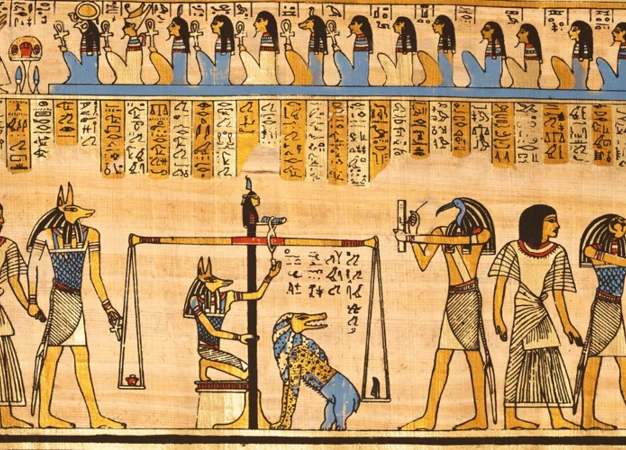Where does one begin when exploring the rich tapestry of religion and mythology in ancient Egypt? A civilization steeped in mysticism and revered deities, the ancient Egyptians held a deep belief in the divine and the afterlife. From the Creation Myth that birthed the world to the beliefs surrounding the journey to the afterlife, their mythology provides us with a captivating glimpse into their spiritual beliefs and rituals. In this article, we will delve into the major gods and goddesses worshiped by the ancient Egyptians, explore their religious practices and rituals, and examine the lasting legacy of their religious beliefs on both ancient and modern societies. Join us on this fascinating journey as we unravel the mysteries of religion and mythology in ancient Egypt.
Contents
- The Importance of Religion in Ancient Egypt
- Overview of Ancient Egyptian Mythology
- Major Gods and Goddesses
- Minor Gods and Goddesses
- Religious Practices and Rituals
- Influence of Religion on Daily Life
- Legacy of Ancient Egyptian Religion
- Conclusion
-
Frequently Asked Questions
- 1. What role did religion play in the daily lives of ancient Egyptians?
- 2. How many gods and goddesses did the ancient Egyptians worship?
- 3. What were the primary functions of temples in ancient Egypt?
- 4. How did the ancient Egyptians prepare for the afterlife?
- 5. Who was the most important god in ancient Egyptian mythology?
- 6. Did the ancient Egyptians believe in multiple afterlife destinations?
- 7. What role did magic and spells play in ancient Egyptian religion?
- 8. How did the ancient Egyptians view animals in relation to their gods and goddesses?
- 9. Were women able to hold positions of religious authority in ancient Egypt?
- 10. How has ancient Egyptian religion influenced modern society?
- References
-
Frequently Asked Questions
- What role did religion play in ancient Egyptian society?
- Who were the major gods and goddesses in ancient Egyptian mythology?
- What were the beliefs about the afterlife in ancient Egypt?
- What was the creation myth in ancient Egyptian mythology?
- How did ancient Egyptians worship their gods and goddesses?
- What were the burial customs and rituals in ancient Egypt?
- Did ancient Egyptians believe in a single god or multiple gods?
- How did religion influence daily life for the ancient Egyptians?
- What was the legacy of ancient Egyptian religion?
- What archaeological evidence supports the existence of ancient Egyptian religion?
- References
- Read More
The Importance of Religion in Ancient Egypt
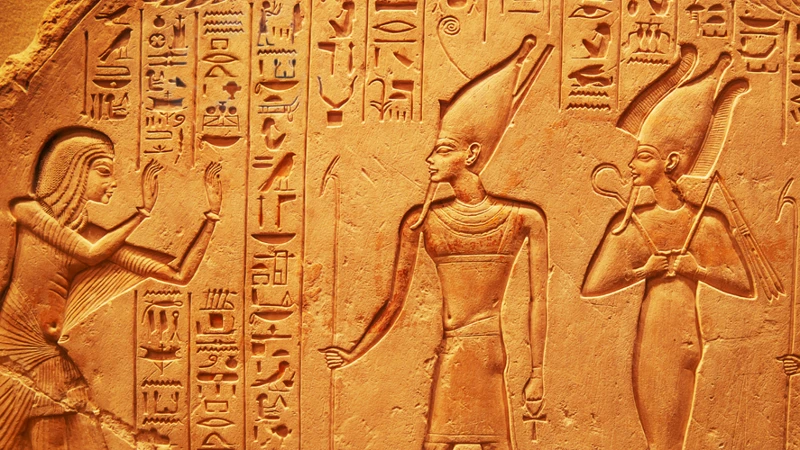
Religion held a paramount importance in the ancient Egyptian society, permeating every aspect of daily life and shaping their worldview. It was not merely a system of belief, but an integral part of their identity as individuals and as a civilization. The Egyptians believed in a complex pantheon of gods and goddesses who governed various aspects of life, from the rising and setting of the sun to the annual flooding of the Nile River that brought fertility to their lands. The religious practices and rituals were deeply ingrained in their societal structure, offering a sense of order and stability. The pharaoh, as the earthly embodiment of the gods, played a crucial role in maintaining ma’at (the concept of divine balance) and ensuring prosperity for the kingdom. The religious institutions, such as temples and cult centers, were centers of power and influence, serving as important economic and political hubs. The Egyptians strongly believed in the afterlife and invested significant resources in preparing for it through elaborate burial customs and funerary rituals. Their profound faith in the divine and the prospect of eternal life shaped their ethics, values, and social interactions. The importance of religion in ancient Egypt cannot be overstated, as it formed the foundation of their culture, providing a cosmic explanation for the mysteries of the world and offering hope for a meaningful existence beyond death. It is through understanding their religious beliefs and practices that we gain insights into the ancient Egyptian civilization and its enduring legacy.
Overview of Ancient Egyptian Mythology
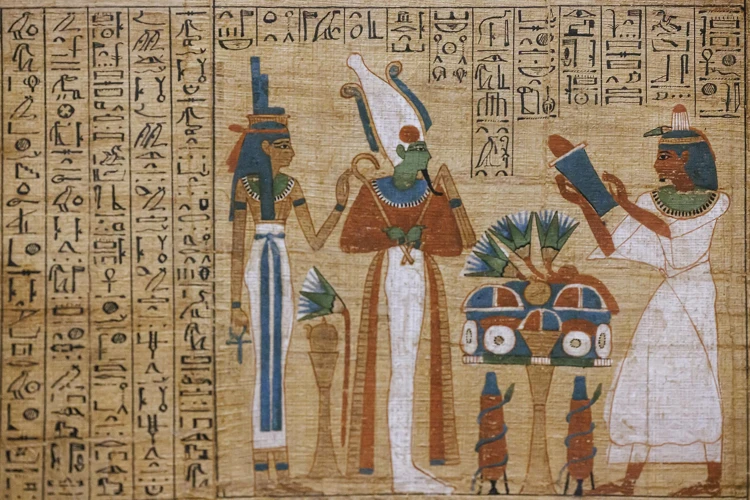
Ancient Egyptian mythology is a captivating tapestry of ancient beliefs and stories that shaped the religious landscape of the civilization. At the core of their mythology lies the Creation Myth, which describes the origin of the world and the divine entities responsible for its existence. According to this myth, the world emerged from the primordial waters of chaos, with the sun god Ra taking a central role in the creation process. The ancient Egyptians also held a profound belief in the afterlife, viewing it as a continuation of earthly existence. Their afterlife beliefs revolved around the judgment of the soul by Osiris, the god of the underworld, and the journey through the Duat, the realm of the dead, where the soul would face trials and challenges. These mythological narratives were not only stories but held deep spiritual significance for the ancient Egyptians, offering them a framework for understanding the world around them and their place within it. The complexity and symbolism within ancient Egyptian mythology continue to fascinate scholars and enthusiasts to this day, providing insights into the profound beliefs and cultural fabric of this ancient civilization.
The Creation Myth
The Creation Myth in ancient Egyptian mythology sheds light on their belief in the origins of the world and the divine forces that shaped it. According to their mythology, in the beginning, there was nothing but the primordial waters called Nu or Nun. Out of these chaotic waters emerged a mound known as the Benben, and atop it stood Atum, the first deity. Atum, also referred to as the “Complete One,” possessed both male and female qualities and was self-created. From Atum’s self-creation, other gods and goddesses were born, including Shu (god of air) and Tefnut (goddess of moisture). These deities, in turn, gave birth to Geb (god of the earth) and Nut (goddess of the sky), who became the parents of Osiris, Isis, Seth, and Nephthys.
The Creation Myth holds a central role in ancient Egyptian cosmology, emphasizing the cyclical nature of creation and the eternal divine order. It signifies the transition from chaos to order and reflects the ancient Egyptians’ deep reverence for the divine power that brought the universe into existence. The belief in the divine origin of the world shaped their understanding of the interconnectedness of all things and reinforced their respect for the natural forces that sustained life.
The Afterlife Beliefs
The afterlife held a central place in the religious beliefs of ancient Egyptians. They believed that death was not the end but rather a transition to another realm where the soul would continue its existence. The concept of the afterlife was closely tied to the weighing of the heart ceremony, which determined the fate of the deceased. According to their belief, upon death, the soul would undergo a series of trials in the Hall of Ma’at, where their heart would be weighed against the feather of Ma’at (representing truth and justice). If their heart was found to be lighter than the feather, it meant that they had led a righteous life, and they would be granted access to the blissful eternal paradise known as the Field of Reeds. However, if their heart was heavy with sin, it would be devoured by the ferocious devourer Ammit, and their soul would cease to exist. To ensure a successful journey into the afterlife, the ancient Egyptians practiced various funerary rituals and burial customs. They meticulously prepared the bodies through the process of mummification, believing that preserving the physical form would enable the soul to recognize and reunite with it in the afterlife. Elaborate tombs, such as the pyramids, were built as eternal resting places for the pharaohs and the elite, filled with precious belongings and provisions for the afterlife, including food, furniture, and even servants. The belief in the afterlife permeated all aspects of their culture and influenced their art, architecture, and religious rituals. It provided a sense of comfort and hope, assuring the Egyptians that death was not the end but rather a continuation of life in a realm of everlasting bliss or eternal punishment for their actions in the mortal world.
(Link to the article about Famous Historical Comets offers a fascinating exploration of comets throughout history and their cultural significance.)
Major Gods and Goddesses
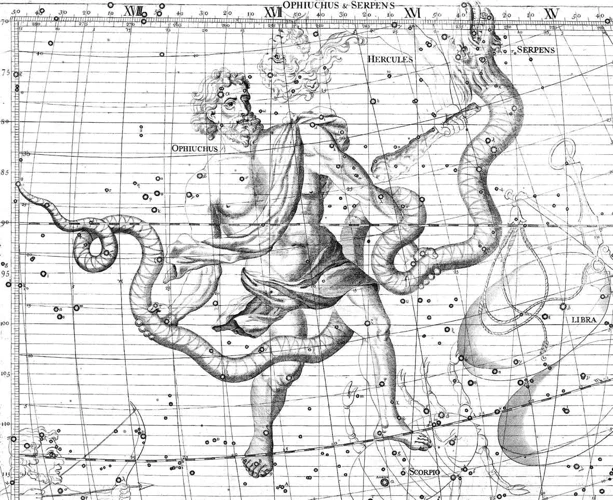
The ancient Egyptian pantheon is adorned with a multitude of major gods and goddesses, each holding significant influence and playing a crucial role in the religious and cultural landscape. Among these deities, Ra, the Sun God, reigns supreme. As the bringer of light and life, Ra was revered as the creator of the world and the ruler of the heavens. Another prominent goddess is Isis, the embodiment of magic and motherhood. She was venerated as the protector of pharaohs and the patroness of fertility. A significant figure associated with death and the afterlife is Anubis, the Guardian of the Dead. Anubis was portrayed with a jackal head and was responsible for guiding the deceased through the perilous journey to the realm of the afterlife. These are just a few examples of the major gods and goddesses worshipped in ancient Egypt, each with their distinct domains and significance. The complexities of this pantheon illustrate the profound spiritual beliefs of the ancient Egyptians, as well as the rich tapestry of their mythology.
Ra: The Sun God
Ra, the mighty Sun God, occupied a central position in the ancient Egyptian pantheon. As the primary deity associated with the sun, Ra represented the life-giving and nurturing power of the sun’s rays. Depicted as a falcon-headed man with a sun disk adorning his head, Ra personified divine kingship and was considered the creator and ruler of all things. According to Egyptian mythology, Ra traveled across the sky in a sun barge during the day and embarked on a perilous journey through the treacherous underworld during the night, emerging victorious the next morning. The worship of Ra was widespread throughout Egypt, and his cult centers, such as Heliopolis, held great prominence.
Ra was believed to bless the earth with light, warmth, and fertility, making him a revered and beloved deity. He was associated with many aspects of life, including growth, agriculture, and the annual flooding of the Nile, which was seen as a result of his blessings. The pharaoh, as the earthly representative of Ra, was believed to be the direct descendant and embodiment of the Sun God’s power and authority. This connection between Ra and the pharaoh provided great legitimacy and divine sanction to the ruler’s reign.
The mythological stories surrounding Ra emphasized his power and importance. One such tale describes Ra as growing weak with age, leading to his detested enemy, Apophis, a serpent of chaos, attempting to devour him and plunge the world into eternal darkness. The ancient Egyptians, to aid Ra in his nightly battles, would perform rituals and prayers to protect him and ensure his victory over the forces of chaos. These rituals were carried out in temples, where priests performed daily ceremonies and made offerings to honor and appease Ra.
Ra’s prominence can also be observed through the architecture and artwork of the time. Temples dedicated to Ra, such as the Great Temple of Amun at Karnak, were grand and awe-inspiring structures, reflecting the significance of the Sun God in the religious and political life of ancient Egypt.
The worship of Ra continued for millennia, and his influence extended to other civilizations that interacted with Egypt. The syncretic nature of ancient religions often resulted in the merging of Ra with other solar deities, such as Amun and Atum, further solidifying his importance.
By understanding Ra’s significance in ancient Egyptian mythology and society, we gain valuable insights into the cultural and religious beliefs that shaped one of the most intriguing civilizations in human history.
Isis: Goddess of Magic
Isis, the enchanting goddess of magic, holds a prominent place in ancient Egyptian mythology. She is revered as a powerful deity associated with healing, protection, and fertility. Often depicted with outstretched wings, Isis is known as the divine mother, revered for her nurturing and compassionate nature. Her role extends beyond magic, as she is considered the ideal wife and mother, embodying qualities of love, devotion, and loyalty. Isis was also a master of using her magical powers for the betterment of humanity, bestowing blessings upon those in need and playing a vital role in the resurrection of her beloved husband Osiris. As the goddess of magic, she possessed the knowledge of the secret arts and was believed to have the ability to control the forces of nature. Her magical abilities were central to her role as a healer, as she used her powers to cure the sick and relieve human suffering. Isis was a symbol of hope, representing the transformative power of magic and the potential for renewal and rebirth. Her worship spread beyond Egypt’s borders, influencing other cultures and religions throughout history. The story of Isis and her magical prowess continues to captivate the imaginations of people around the world, highlighting the enduring fascination with ancient Egyptian mythology.
Anubis: Guardian of the Dead
Anubis, often depicted with the head of a jackal, was one of the most iconic gods in ancient Egyptian mythology. As the Guardian of the Dead and the Embalmer, Anubis played a crucial role in the funerary rituals and the journey to the afterlife. His primary responsibility was to guide and protect the souls of the deceased as they made their way through the perilous underworld. Anubis was believed to weigh the hearts of the deceased against the feather of Ma’at to determine their fate in the afterlife. If the heart was found to be pure and balanced, the soul would be granted eternal life. To highlight his importance, Anubis was often invoked during the process of mummification, with priests wearing jackal masks and performing rituals to honor and appease him.
Anubis also had a significant association with cemeteries and tombs, representing the transition from life to death. Temples dedicated to Anubis were built near burial grounds, and his statues were placed at the entrance of tombs as a protective presence. Additionally, his role extended beyond the realm of the dead, as he was also regarded as the patron god of embalmers, providing them with the necessary knowledge and skills to prepare the bodies for the afterlife.
Throughout Egyptian history, Anubis remained a revered and respected deity, with his presence permeating funeral rites and burial customs. His iconic imagery, with the jackal head and black or blue color symbolizing death and rebirth, symbolized the everlasting cycle of life and resurrection. Anubis continues to captivate the imaginations of people today, serving as a reminder of the ancient Egyptians’ profound belief in the afterlife and their elaborate rituals surrounding death.
Minor Gods and Goddesses
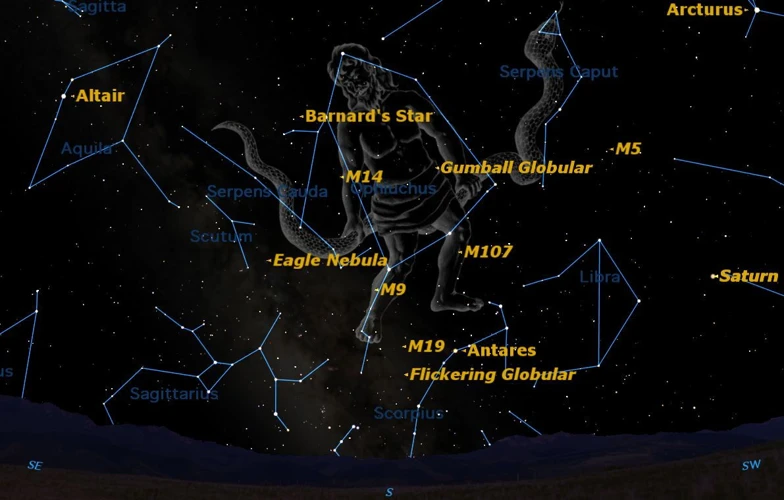
In addition to the major gods and goddesses, the ancient Egyptian pantheon was also populated by a myriad of minor deities who held specific roles and responsibilities. These lesser-known gods and goddesses played vital roles in different aspects of ancient Egyptian life. One such deity was Bastet, the goddess of home and protection, revered for her role in safeguarding the household and warding off evil spirits. Another prominent figure was Thoth, the god of wisdom and writing, who was credited with inventing hieroglyphics and serving as the scribe of the gods. Sekhmet, the goddess of war and healing, embodied the power of destruction and the ability to bring about healing and restoration. These minor gods and goddesses, though often overshadowed by their more renowned counterparts, played significant roles in the religious and cultural tapestry of ancient Egypt, influencing the daily lives and beliefs of the people. They further exemplify the intricacy and depth of the ancient Egyptian pantheon.
Bastet: Goddess of Home and Protection
Bastet, the Goddess of Home and Protection, was one of the most revered deities in ancient Egyptian mythology. She was often depicted as a lioness or as a woman with the head of a lioness and was associated with domesticity, fertility, and the protection of the pharaoh and their subjects. Bastet was believed to safeguard the home, warding off evil spirits and ensuring a harmonious household. She was also the goddess of joy, music, and dance, bringing merriment and celebrations to the lives of the Egyptians.
In the ancient Egyptian pantheon, Bastet was seen as a gentle and nurturing deity, known for her maternal qualities. She was believed to possess a caring and protective nature, particularly towards children and the vulnerable. Many Egyptians would invoke her name for safety and security, seeking her guidance and blessings in their daily lives. Statues and amulets of Bastet were commonly kept in homes as a form of protection, while her temples were centers of worship and pilgrimage.
It is interesting to note that over time, the role of Bastet evolved. Originally, she was associated with the lioness, symbolizing ferocity and divine retribution. However, as Egyptian society shifted towards a more peaceful and stable era, the gentle aspects of Bastet became more prominent. This transformation reflected the changing beliefs and values of the ancient Egyptians.
Bastet, the Goddess of Home and Protection, held a significant place in ancient Egyptian mythology. Her role in protecting the home and bringing joy to the lives of the people exemplifies the importance of domestic life and the well-being of the family unit in Egyptian society. The worship of Bastet showcased the Egyptians’ desire for safety, harmony, and happiness in their daily lives.
Thoth: God of Wisdom and Writing
Thoth, the ancient Egyptian god of wisdom and writing, played a crucial role in the pantheon of deities. He was often depicted with the head of an ibis or a baboon, which symbolized his association with intelligence and knowledge. Thoth was believed to be the inventor of writing, and he was venerated as the scribe of the gods, responsible for recording and maintaining divine knowledge. It was said that Thoth not only wrote the world into existence but also possessed the power to calculate and measure time.
The wisdom and expertise of Thoth extended beyond writing and recording. He was regarded as the mediator and arbitrator of disputes among the gods. In this role, Thoth was known as the voice of reason and justice, upholding ma’at (divine balance) and ensuring harmony in the cosmic order. It was also believed that Thoth possessed the power of prophecy, enabling him to foresee events and communicate messages from the gods to both mortals and other deities.
Thoth’s association with writing, knowledge, and wisdom made him a patron deity of scholars, scribes, and intellectuals in ancient Egypt. His influence was felt not only in religious contexts but also in practical matters such as legal documentation, administrative records, and scientific writings. The ancient Egyptians credited Thoth with the development of various branches of knowledge, including mathematics, astronomy, and medicine.
It is important to note that Thoth’s significance in ancient Egyptian society was not limited to intellectual pursuits. He was also associated with magic and healing. His knowledge of spells and incantations made him a powerful ally for those seeking protection from evil forces or healing from ailments. Thoth’s role in both the intellectual and mystical realms made him a highly respected and revered deity.
Thoth, the god of wisdom and writing, played a multifaceted role in ancient Egyptian mythology and society. From his invention of writing to his role as a mediator and guardian of knowledge, Thoth exemplified the importance of intellect and learning in the ancient Egyptian worldview. His association with magic and healing added to his revered status, making him a deity worthy of admiration and worship.
Sekhmet: Goddess of War and Healing
Sekhmet, the fearsome lioness-headed goddess, held dual roles as both a goddess of war and healing in ancient Egyptian mythology. She was believed to possess immense power and ferocity, capable of both destruction and restoration. As the goddess of war, Sekhmet was invoked to protect the pharaoh and the kingdom in times of conflict, representing the aggressive and victorious aspect of battle. She was often depicted wielding a spear and wearing the sun disk, symbolizing her connection to the powerful sun god, Ra. However, Sekhmet’s role extended beyond warfare. She was also revered as the goddess of healing and medicine – a paradoxical combination of aggression and compassion. It was believed that she had the ability to cure illnesses and dispel plagues. Temples dedicated to Sekhmet were centers for both martial training and medical care, where priests and priestesses practiced various healing techniques, including herbal medicine and incantations.
Sekhmet’s role as a healing goddess was closely tied to her association with the sun and its life-giving properties. The sun’s heat and light were believed to possess purifying and rejuvenating qualities, similar to the power of Sekhmet’s healing touch. This belief is showcased in the legend of Ra sending Sekhmet to punish humanity for their disobedience. When Sekhmet’s rampage became uncontrollable, Ra tricked her into drinking beer mixed with red dye, making it appear as if she were consuming blood. In her intoxicated state, Sekhmet’s destructive powers were pacified, and she transformed into the benevolent goddess Hathor, bringing about healing and fertility to the land.
The worship of Sekhmet played a significant role in ancient Egyptian society, as people sought her protection, strength, and healing abilities. She embodied the concept of the divine balance between chaos and order, destruction and creation. Today, the powerful image of Sekhmet, symbolizing both war and healing, continues to captivate and inspire, reminding us of the complex and multifaceted nature of ancient Egyptian mythology.
Religious Practices and Rituals
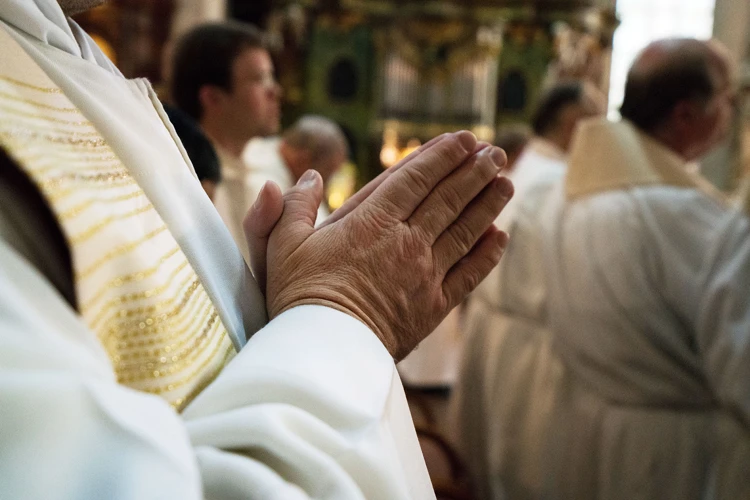
Religious practices and rituals played a central role in the daily lives of the ancient Egyptians, intertwining the divine with the earthly realm. Temples were the epicenter of religious activity, serving as sacred spaces where individuals offered their devotion to the gods and sought their divine favor. These magnificent structures were filled with ornate statues and intricately carved reliefs, creating a visually captivating environment. Rituals included purification rites, offerings of food and drink, and the recitation of prayers and hymns. The offerings were made to nourish and sustain the deities, so they would provide blessings and protection to the worshippers. The Egyptians believed that maintaining harmony and balance in the world required regular rituals, and failing to perform them could bring calamity and chaos. Funerary rituals were also an essential part of their religious practices, ensuring a smooth journey to the afterlife for the deceased. The mummification process, burial customs, and the construction of elaborate tombs were all meticulously carried out to ensure the preservation of the body and the soul’s safe passage to the realm of Osiris. These religious practices and rituals not only fostered a sense of connection with the divine but also provided a framework for moral and ethical behavior. Through the performance of these rituals, the ancient Egyptians sought to maintain cosmic order and secure blessings for themselves and their society.
Temples and Offerings
Temples were the grand architectural embodiments of religious devotion in ancient Egypt. These sprawling structures served as the physical dwelling places for the gods, where people could come to worship and make offerings. Constructed with meticulous precision and adorned with intricate hieroglyphs, temples were designed to evoke a sense of awe and reverence. The most famous of these temples is the Temple of Karnak in Luxor, which spanned over 100 acres and was dedicated to the worship of Amun-Ra, the king of the gods. Other notable temples include the Temple of Abu Simbel and the Temple of Luxor.
Inside these sacred spaces, Egyptians performed religious rituals and ceremonies conducted by the priests, who served as intermediaries between the mortal world and the divine realm. Offerings played a crucial role in these rituals, as they were believed to nourish and sustain the gods while establishing a reciprocal relationship between humans and the divine. Offerings ranged from food and drink to beautifully crafted statues, jewelry, and even animals. The Egyptians believed that by presenting these offerings, they could appease the gods and seek their favor and protection. The offerings were often left on altars or placed in designated offering chambers within the temples.
Temples served as important centers for economic and social activities. They employed a significant number of priests, scribes, and laborers who were responsible for the maintenance of the temple and its grounds. Temples also possessed vast wealth and extensive lands, making them influential in economic affairs. Temples organized festivals and religious processions, providing opportunities for communal gatherings and celebrations. These events brought people from all walks of life together, fostering a sense of unity and shared identity among the ancient Egyptians.
Funerary Rituals and Burial Customs
Funerary rituals and burial customs held significant importance in ancient Egyptian society, as they were intrinsically linked to their beliefs about the afterlife. The ancient Egyptians believed that death was merely a transition to another realm, and meticulous preparations were made to ensure a favorable journey and eternal existence in the afterlife. The process of mummification was a central aspect of their funerary rituals. It involved carefully preserving the body to prevent decay, with organs removed, except for the heart, which was believed to be the seat of intelligence and emotions. The body was then treated with natron, a natural salt, and wrapped in multiple layers of linen bandages, often interspersed with amulets and charms for protection. The tombs were constructed to serve as eternal homes for the deceased, ranging from simple rock-cut chambers to elaborate pyramids for royalty. These tombs were filled with provisions and personal belongings, reflecting the belief that the deceased would need these in the afterlife. The ancient Egyptians also practiced ancestor worship, with regular offerings and rituals conducted at the tombs to honor and sustain the spirits of the deceased. The Book of the Dead, a collection of spells and prayers, was another crucial component of funerary rituals, guiding and assisting the departed soul through the journey to the afterlife. Each aspect of the funerary rituals and burial customs was carried out with utmost care and precision, demonstrating the deep reverence and belief in the continuation of existence beyond death.
Influence of Religion on Daily Life
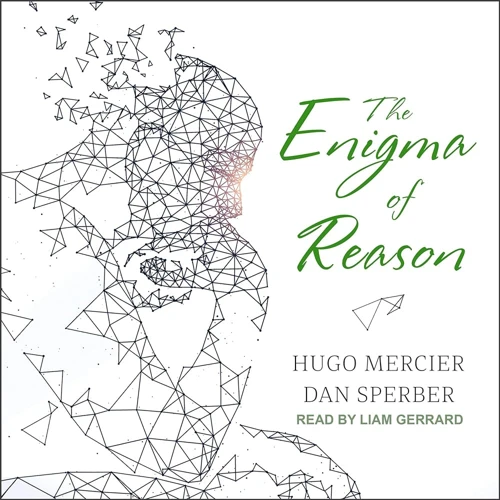
The influence of religion on daily life in ancient Egypt was profound and far-reaching. Religion permeated every aspect of society, shaping the beliefs, behaviors, and interactions of its people. The Egyptians believed that their lives were intricately intertwined with the divine, and they sought to maintain a harmonious relationship with the gods and goddesses through various rituals and practices. Daily life revolved around the observance of religious duties and customs, such as making offerings to the gods, participating in temple ceremonies, and consulting oracles for guidance. Religious festivals and processions were celebrated throughout the year, providing opportunities for communal worship and social cohesion. The religious calendar dictated the timing of agricultural activities, as the Egyptians believed that the gods controlled the flood cycles of the Nile, upon which their livelihoods depended. The pharaoh, as the earthly representative of the gods, played a crucial role in religious ceremonies and was seen as the intermediary between the divine and the mortal realms. The belief in the afterlife also influenced daily life, as the Egyptians strove to live virtuous lives in order to secure a favorable judgment in the afterworld. The construction of monumental tombs and the preservation of the deceased’s physical body through mummification were testament to their dedication to the belief in an eternal existence. The influence of religion extended beyond individual practices and rituals, shaping social norms, laws, and hierarchies. It provided a moral framework for behavior, emphasizing virtues such as honesty, compassion, and respect for authority. Religion played a role in the education system, with children being taught about the myths, legends, and religious stories that underpinned their culture. The influence of religion on daily life fostered a sense of community, unity, and purpose among the ancient Egyptians, instilling in them a reverence for the divine and a deep commitment to upholding the principles of ma’at – the cosmic balance and order.
Legacy of Ancient Egyptian Religion
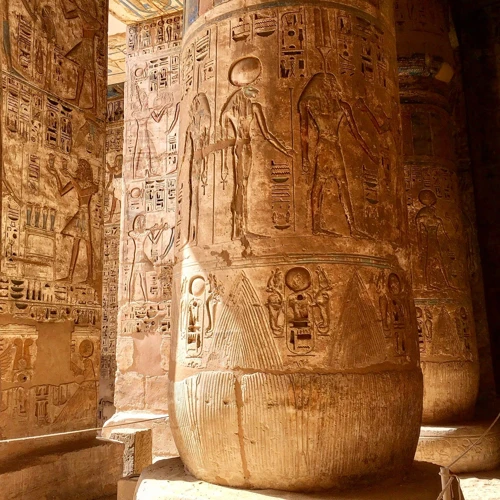
The legacy of ancient Egyptian religion can be witnessed in various aspects of contemporary society. The religious beliefs and practices of the ancient Egyptians continue to captivate and inspire people worldwide. One of the most notable legacies is the fascination with Egyptian mythology and the gods and goddesses of ancient Egypt. From literature and art to movies and video games, the imagery and stories associated with Egyptian deities persist as a source of inspiration and creativity. The influence of ancient Egyptian religious concepts can be observed in modern spiritual practices and New Age movements, where ideas such as the existence of an afterlife and the worship of nature and celestial entities find resonance. The architectural and engineering marvels of ancient Egyptian temples and monuments continue to awe and inspire awe-inspiring structures such as the Great Pyramids of Giza. These iconic structures stand as a testament to the advanced knowledge and ingenuity of the ancient Egyptians, and their religious significance adds an additional layer of wonder. Additionally, the legacy of ancient Egyptian religion can be seen in the preservation and study of artifacts and texts. The deciphering of hieroglyphics and the translation of ancient Egyptian texts have provided valuable insights into their religious beliefs and rituals. These discoveries have greatly contributed to our understanding of ancient Egyptian culture, history, and spirituality. Finally, the lasting impact of ancient Egyptian religion can be seen in the rituals and traditions that have survived through the ages. While the modern practice of these rituals often varies from their ancient counterparts, the underlying principles and symbolism remain intact. From the celebration of the winter solstice to the preservation of certain burial customs, echoes of ancient Egyptian religious practices can still be found in various cultures around the world. The legacy of ancient Egyptian religion is one of endurance, leaving an indelible mark on both ancient and modern societies alike.
Conclusion

In conclusion, delving into the world of religion and mythology in ancient Egypt reveals a deep and profound connection between the spiritual realm and the everyday lives of the people. The importance of religion in ancient Egypt cannot be understated. It served as the foundation of their culture, providing explanations for the mysteries of the world and offering guidance for ethical living. The pantheon of gods and goddesses, from Ra the Sun God to Isis the Goddess of Magic, shaped their beliefs and rituals. Temples and funerary practices played a central role in religious life, serving as centers of power and offering a sense of community. The legacy of ancient Egyptian religion can still be felt today, influencing not only subsequent civilizations but also contemporary art, literature, and popular culture. By exploring the rich tapestry of religion and mythology in ancient Egypt, we gain a deeper understanding of the complexities of this ancient civilization and the enduring impact of their religious beliefs.
Frequently Asked Questions

1. What role did religion play in the daily lives of ancient Egyptians?
Religion was deeply intertwined with every aspect of ancient Egyptian life. It provided a framework for understanding the world, guided their moral and ethical values, influenced social and political structures, and offered a sense of security and hope for the afterlife.
2. How many gods and goddesses did the ancient Egyptians worship?
The ancient Egyptians worshiped a vast pantheon of gods and goddesses. Estimates suggest that there may have been over 2,000 individual deities, each with their own special attributes, domains, and cult followings.
3. What were the primary functions of temples in ancient Egypt?
Temples served as sacred spaces dedicated to specific gods and goddesses. They were not just places of worship but also centers of economic, educational, and political activities. The temples housed statues of the deities, offered a space for rituals and offerings, and played a crucial role in administering the daily affairs of the state.
4. How did the ancient Egyptians prepare for the afterlife?
The ancient Egyptians believed in an afterlife and devoted considerable resources to ensure a successful journey after death. They mummified their deceased loved ones, constructed elaborate tombs and burial chambers, and filled them with provisions and belongings necessary for the afterlife.
5. Who was the most important god in ancient Egyptian mythology?
Ra, the sun god, held a position of great importance in ancient Egyptian mythology. He was considered the creator of the world and the ruler of the gods. Ra represented the power of the sun and was closely associated with kingship and the pharaoh.
6. Did the ancient Egyptians believe in multiple afterlife destinations?
Yes, the ancient Egyptians believed in multiple afterlife destinations. They believed that the god Osiris judged the souls of the deceased and determined their fate after death. The worthy would attain an eternal paradise known as the Field of Reeds, while the unworthy faced a perilous journey or eternal punishment.
7. What role did magic and spells play in ancient Egyptian religion?
Magic and spells were an integral part of ancient Egyptian religious practices. They believed that specific rituals, incantations, and amulets held the power to protect against evil, ward off illness, and ensure a successful afterlife. Priests and priestesses often performed magical rites and spells on behalf of the people.
8. How did the ancient Egyptians view animals in relation to their gods and goddesses?
Animals held a special significance in ancient Egyptian religion. Certain animals were considered sacred representations of specific gods and goddesses. The Egyptians believed that the animals possessed a divine connection and venerated them through animal cults, mummification, and annual festivals.
Absolutely. Women in ancient Egypt had the opportunity to hold positions of religious authority. Some women served as priestesses, temple singers, or oracles, and often played a crucial role in religious rituals and ceremonies.
10. How has ancient Egyptian religion influenced modern society?
Ancient Egyptian religion has left a lasting impact on various aspects of modern society. Its symbols, myths, and deities continue to fascinate and inspire artists, writers, and filmmakers. Additionally, its concepts of the afterlife, ethical values, and even aspects of magic and rituals have found their way into various spiritual and religious practices around the world.
References
Frequently Asked Questions

What role did religion play in ancient Egyptian society?
Religion played a central role in ancient Egyptian society, influencing all aspects of life from government to daily activities. It provided a framework for moral and ethical behavior, offered explanations for the natural world, and served as a source of comfort and security.
Who were the major gods and goddesses in ancient Egyptian mythology?
Ancient Egyptian mythology featured a pantheon of gods and goddesses, including Ra, the sun god; Isis, the goddess of magic; and Anubis, the guardian of the dead. These deities were highly revered and believed to have immense power and influence.
What were the beliefs about the afterlife in ancient Egypt?
Ancient Egyptians believed in an afterlife that mirrored their earthly existence. They believed that after death, the soul would embark on a perilous journey through the underworld, and only those who passed the judgment of Osiris, the god of the dead, would be granted eternal life.
What was the creation myth in ancient Egyptian mythology?
The ancient Egyptians had various creation myths, but the most popular one involved the god Atum creating the world by rising out of the primordial waters. Atum then brought forth the other deities and created the elements necessary for life to thrive.
How did ancient Egyptians worship their gods and goddesses?
Ancient Egyptians worshiped their gods and goddesses in temples dedicated to specific deities. They made daily offerings of food, drink, and incense and performed rituals and ceremonies to show their devotion. Festival processions and offerings were also common during religious celebrations.
What were the burial customs and rituals in ancient Egypt?
Ancient Egyptians believed in preserving the body for the afterlife, and mummification was an important part of their burial customs. The deceased were often buried with valuable possessions, and elaborate tombs and pyramids were constructed to ensure a comfortable journey to the afterlife.
Did ancient Egyptians believe in a single god or multiple gods?
Ancient Egyptians believed in multiple gods and goddesses. While they acknowledged that certain deities held more power and influence than others, they believed that each deity had a specific role and purpose in maintaining order and balance in the universe.
How did religion influence daily life for the ancient Egyptians?
Religion had a profound impact on daily life in ancient Egypt. It dictated social and moral norms, influenced government decisions, and guided individuals in their personal and professional lives. Religious rituals and practices were woven into the fabric of daily routines, offering a sense of structure and purpose.
What was the legacy of ancient Egyptian religion?
The legacy of ancient Egyptian religion is still felt today. Many of the gods and goddesses from ancient Egyptian mythology have been reimagined and incorporated into modern popular culture. The ancient Egyptian belief in an afterlife and the preservation of the body also influenced the burial customs and practices of other civilizations.
What archaeological evidence supports the existence of ancient Egyptian religion?
Archaeological discoveries, such as temple ruins, burial sites, and inscriptions, provide substantial evidence for the existence and practice of ancient Egyptian religion. The hieroglyphic texts found on temple walls and papyrus scrolls offer detailed insights into religious rituals, beliefs, and mythological stories.

